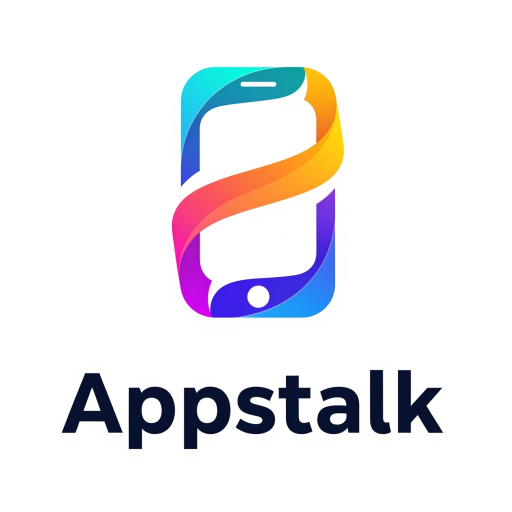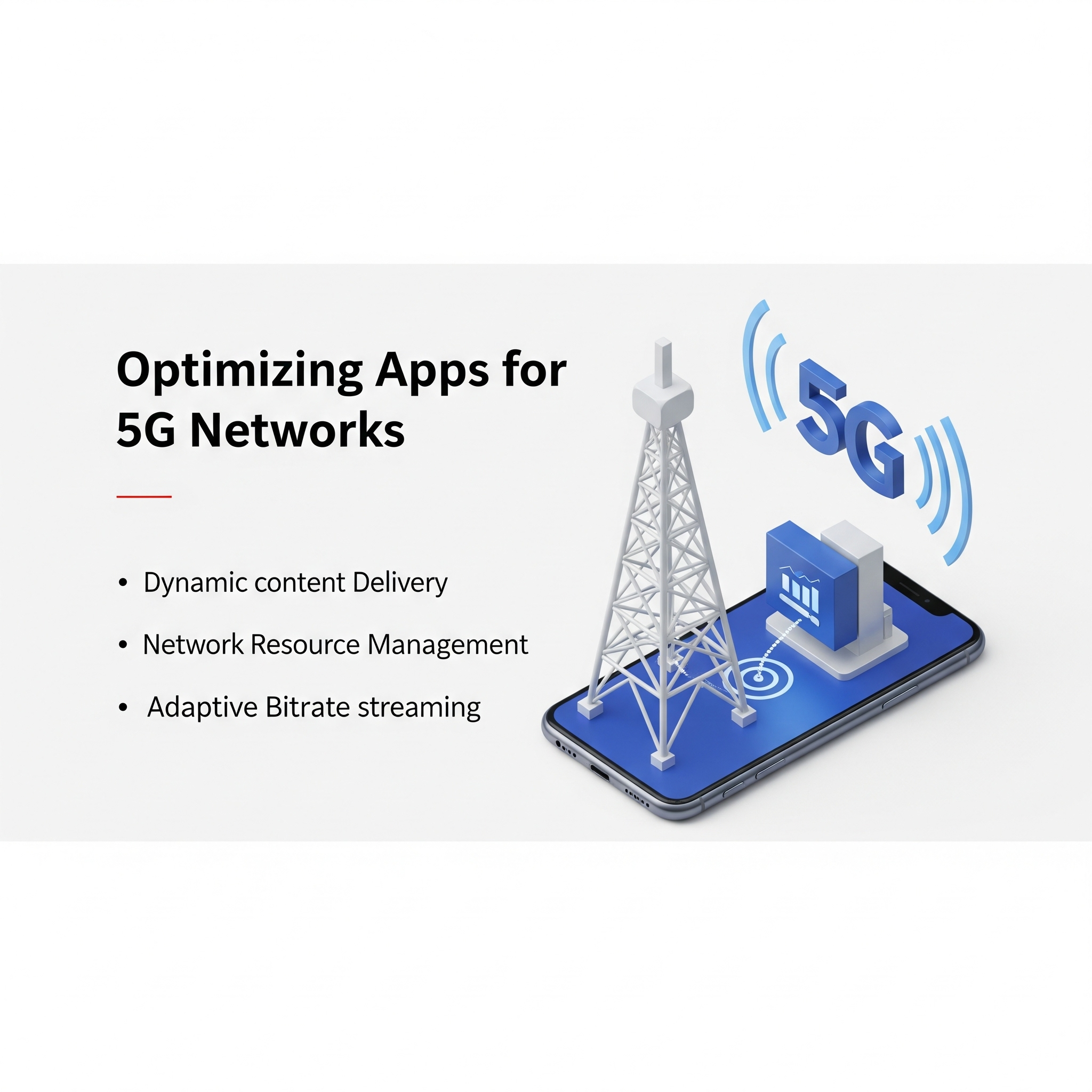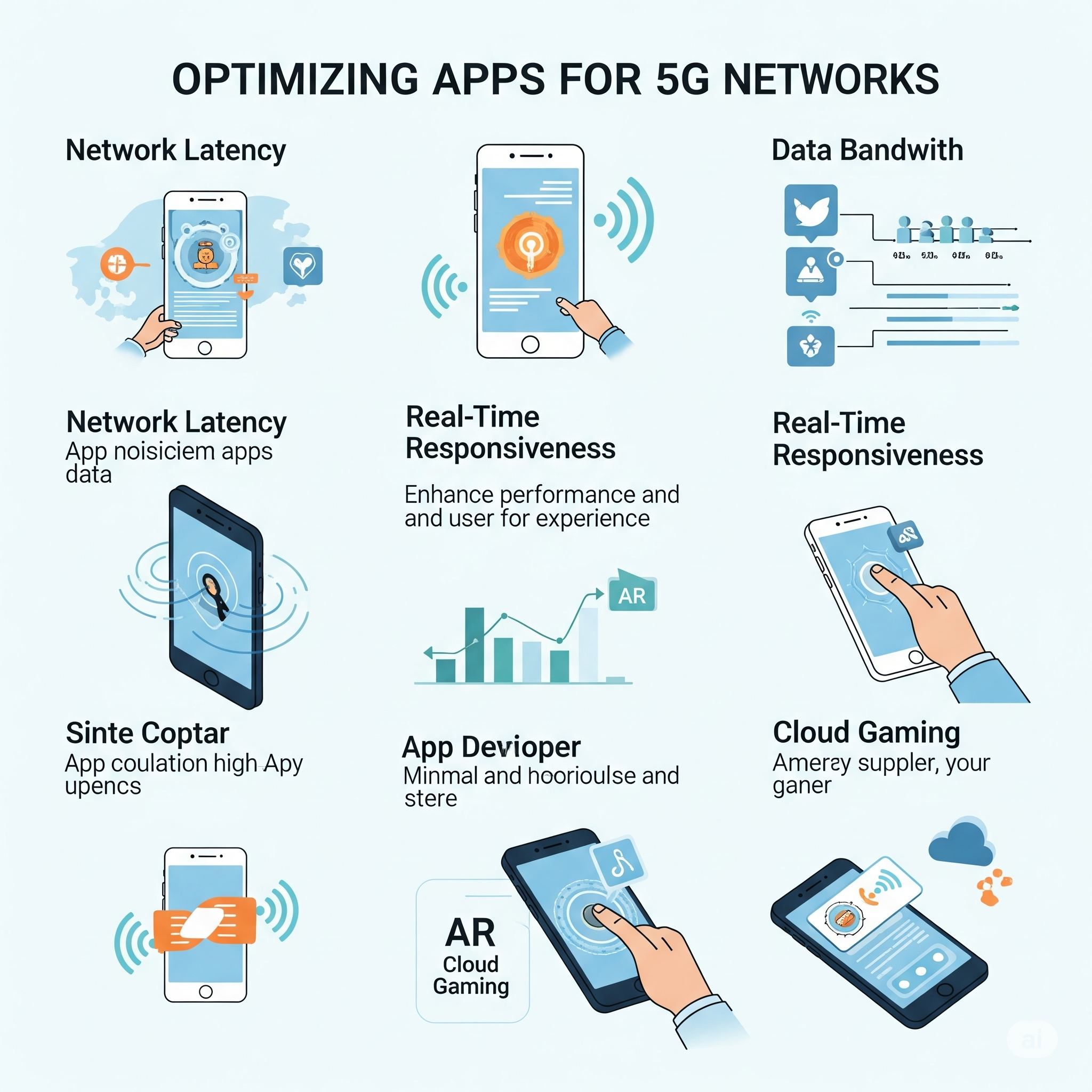Unlocking the Next Generation
of Mobile Experiences
Introduction
The dawn of 5G networks has brought with it a new era of possibilities for mobile applications. With unprecedented speeds, ultra-low latency, and greater bandwidth, 5G isn’t just a step up from its predecessor—it’s a giant leap forward. But to fully harness the potential of this trans formative technology, developers must rethink how they design, build, and optimise mobile apps.
In this comprehensive post, we explore how developers can optimise apps for 5G networks, the benefits and challenges of 5G, and actionable strategies to deliver next-generation app experiences that are faster, smarter, and more engaging.
Understanding 5G: What Makes It Different?
Before diving into optimisation techniques, it’s essential to understand what sets 5G apart:
- Speed: 5G networks offer speeds up to 10 Gbps—up to 100x faster than 4G.
- Latency: Latency can drop as low as 1 millisecond, enabling real-time responsiveness.
- Capacity: Higher bandwidth allows more devices to connect simultaneously without network congestion.
- Reliability: Enhanced network slicing ensures stable connections for critical services.
- Efficiency: Energy and spectral efficiency make 5G more sustainable and performance-oriented.
These attributes have far-reaching implications for how apps function and what users expect.
Why Optimise for 5G?
Developing with 5G in mind isn’t just about taking advantage of faster speeds. It’s about transforming user experiences and tapping into new categories of mobile applications that weren’t feasible before. These include:
- Cloud gaming and XR (AR/VR)
- Remote surgeries and telemedicine
- Autonomous vehicles and IoT apps
- AI-driven real-time apps
Apps that aren’t optimised for 5G might not see performance gains or may even degrade under new network behaviours.
Key Considerations for 5G App Optimisation
1. Latency Sensitivity and Real-Time Interaction
Apps like online games, video conferencing, and AR need ultra-low latency to feel seamless.
- Use UDP instead of TCP for time-sensitive data.
- Implement Edge Computing to bring data processing closer to the user.
- Use predictive prefetching to reduce perceived lag.
2. Bandwidth Utilisation and Adaptive Streaming
With higher bandwidth, apps can support richer content, but efficient delivery is key.
- Use adaptive bitrate streaming for video to match real-time network conditions.
- Compress large media files on the server side and decompress client-side.
- Use content delivery networks (CDNs) to distribute load.
3. Edge and Fog Computing Integration
5G enables edge computing by placing servers closer to users.
- Offload compute-heavy tasks (like rendering, analytics) to edge nodes.
- Ensure that app architecture supports decentralised processing.
- Combine edge computing with cloud for hybrid workflows.
4. Device and Network Awareness
Make your app aware of the type of network it’s running on and adapt dynamically.
- Use network callbacks/APIs to detect 5G and adjust resource usage accordingly.
- Implement dynamic asset loading: only fetch high-res assets when on fast connections.
- Offer offline modes or reduced data modes for network transitions.
5. Security and Privacy in a 5G World
More connected devices and faster networks increase attack surfaces.
- Use zero-trust security models.
- Encrypt all communications end-to-end.
- Leverage 5G-native security features like network slicing isolation.
6. Power Efficiency and Battery Optimization
Higher data throughput can drain batteries faster.
- Schedule background updates and downloads intelligently.
- Use push notifications over polling.
- Monitor and reduce CPU/GPU usage with analytics.
Technologies Empowered by 5G: Opportunities for Developers
Cloud Gaming
5G enables low-latency streaming of console-quality games without high-end hardware.
- Optimise for frame pacing and input lag reduction.
- Offload rendering to powerful cloud GPUs.
- Ensure fast state syncing and reconnections.
AR/VR/XR Experiences
With faster data transfer and low latency, immersive apps are more feasible.
- Use SLAM (Simultaneous Localisation and Mapping) for precise tracking.
- Minimise load times with asset streaming.
- Integrate with edge-based rendering for lighter client apps.
⚕️ Telemedicine
Doctors can provide real-time video consultations and even remote surgeries.
- Ensure HIPAA/GDPR compliance.
- Use adaptive streaming to handle network shifts.
- Implement secure identity verification mechanisms.
⚡ Real-Time AI & Machine Learning
AI models can run in the cloud and provide inference results in real-time.
- Use Federated Learning to train models without compromising data privacy.
- Use real-time analytics to personalise experiences.
- Stream ML results directly to the app UI.
IoT and Smart Cities
With the capacity to connect millions of devices per square kilometer, 5G powers smart infrastructure.
- Use efficient protocols like MQTT or CoAP.
- Design for intermittent connectivity.
- Secure all endpoints with hardware-level encryption.
Challenges in Optimising for 5G
1. Device Fragmentation
Not all devices support 5G, so backward compatibility is essential.
- Design fallbacks for 4G or Wi-Fi.
- Use feature flags and modular builds.
2. Inconsistent Network Availability
5G roll out is ongoing and coverage may vary.
- Test under variable conditions using simulators.
- Implement graceful degradation strategies.
3. Cost and Complexity of Edge Integration
Deploying edge infrastructure requires planning.
- Consider serverless edge solutions for scalability.
- Work with providers that offer 5G SDKs and APIs.
Best Practices for Developers
- Build with modular architecture to support future enhancements.
- Use analytics tools to monitor performance across different networks.
- Follow design for failure principles: expect packet loss, reconnections.
- Test apps on real 5G devices and networks, not just simulators.
- Regularly update app libraries and dependencies.
The Role of AI in 5G App Optimisation
AI and 5G form a powerful combination. Use AI to:
- Predict network conditions and prefetch resources
- Automatically compress and deliver optimal content
- Identify user behaviour and tailor app performance dynamically
Real-World Examples
- Netflix uses adaptive bitrate streaming to deliver content efficiently over variable networks.
- Snap chat uses 5G to improve AR lens performance and rendering.
- Twitch and YouTube optimise for ultra-low latency streaming on 5G.
The Future of 5G App Development
As 5G matures, app development will shift toward even more cloud-native, decentralised, and immersive paradigms. Expect:
- Hyper-personalised experiences powered by real-time data
- Cross-platform streaming apps using cloud rendering
- Greater synergy between mobile, IoT, and AI systems
Conclusion
5G is not just a technological upgrade—it’s a complete shift in how apps are designed, delivered, and experienced. Developers who embrace this shift by optimizing their apps for 5G will unlock new capabilities, enter new markets, and deliver groundbreaking user experiences.
From lower latency to edge computing and adaptive streaming, the path to 5G-optimised apps is full of exciting opportunities. The time to adapt is now.
Build smart. Build fast. Build for 5G.




